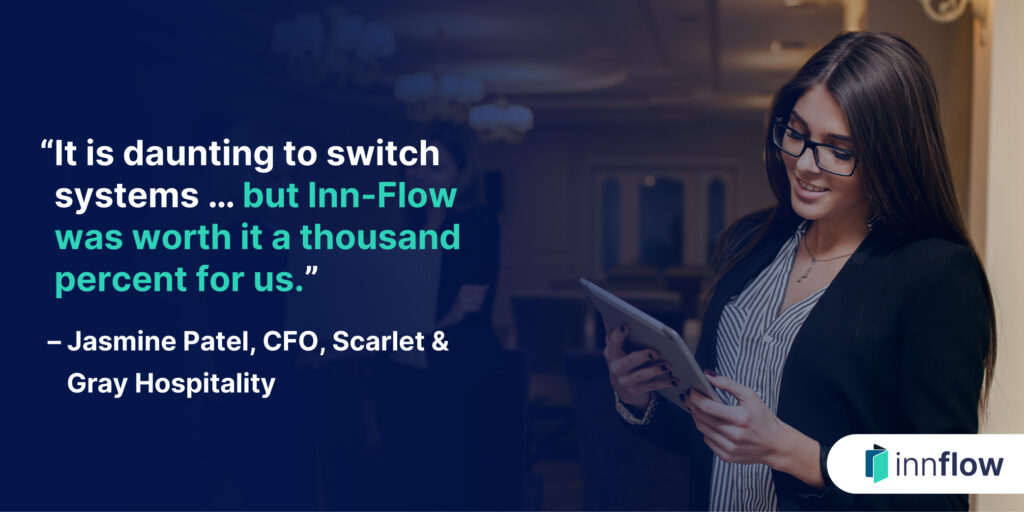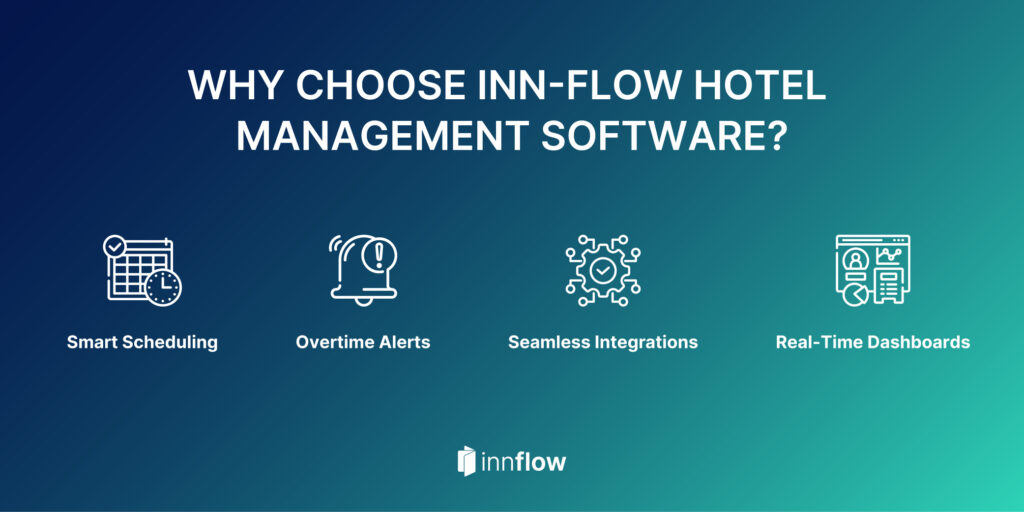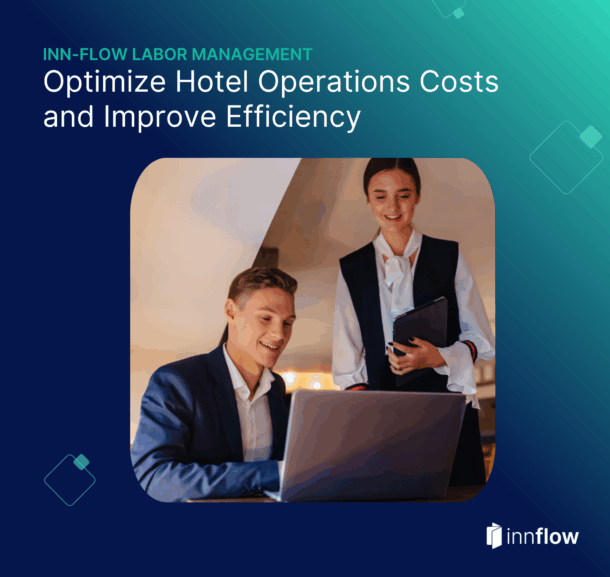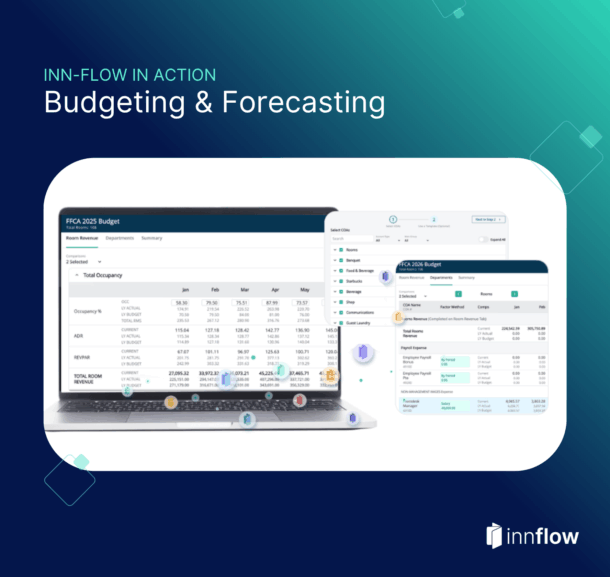Labor costs are undoubtedly one of the top-line items on any hotel’s profit and loss (P&L) statement. After all, the impact of inefficient staffing is felt beyond the rising cost of labor, but also in guest satisfaction scores, team morale, and profitability. And over time, understaffing and high turnover rates take a significant toll.
Today, mastering hotel labor cost optimization is no longer optional for general managers (GMs), but rather essential for demonstrating ROI to owners while making sure operations run smoothly.
That’s where solutions like Inn-Flow’s hotel labor management software come in. By combining automation, integrations, and real-time visibility, GMs are given the right tools to proactively manage labor costs and protect profit margins, all while building a stronger team.
Understanding Hotel Labor Costs
Hotel labor costs can be grouped into two main categories: direct and indirect labor.
- Direct labor refers to employees who directly serve guests, including housekeeping, front desk, food and beverage, and maintenance.
- Indirect labor refers to management, administrative staff, and support functions that keep operations moving, often behind the scenes.
Across both categories, costs are steadily rising due to a number of factors.
For one, minimum wage has increased in recent years, with areas like Los Angeles implementing a $30 an hour ordinance for hotel workers. Increased demand for overtime, operational inefficiencies, and other turnover-related expenses also account for stretched budgets.
According to a recent analysis, hotels everywhere are feeling this “labor cost squeeze” as expenses grow faster than revenue. Hotel wages alone have increased 15% since 2019, far exceeding revenue growth.
To combat these rising costs, many in the industry are turning to scheduling technology to optimize direct labor challenges. This technology is instrumental in helping managers accurately predict staffing needs based on historical data analysis and real-time data integration.
One of the most exciting recent innovations in hotel operations has been the implementation of scheduling technology.
Scheduling software helps managers accurately predict staffing needs based on information such as historical data analysis and real-time data integration. This, paired with flexible staffing models and cross-training, can help GMs streamline operations.
And per SiteMinder, hotels that streamline these everyday workflows can reduce labor costs by up to 15%, freeing up budgets to reinvest in guest-focused upgrades.
The Cost of Inefficient Labor Management
When labor is mismanaged, the costs show up quickly on the P&L. Overstaffing drives up unnecessary expenses, while understaffing quickly leads to poor guest experiences and overworked employees. And scheduling errors often trigger avoidable overtime, which, of course, compounds these issues.
For example, Scarlet & Gray Hospitality used Inn-Flow’s labor management tools to identify issues before they hit the P&L. By catching scheduling inefficiencies early, they were able to reduce overtime and improve visibility into their true labor costs.

Another hidden cost that comes from inefficient scheduling is high turnover rates. High turnover not only increases recruitment and training expenses but also disrupts service consistency and potential guest satisfaction ratings.
With hotel employees averaging thousands in replacement costs, labor mismanagement directly drains profitability.
Strategies for Labor Cost Optimization
Hotels that adopt a proactive approach to reducing their rising labor costs can more successfully protect profit margins while building resilient teams. But to do this well, there are a few key strategies required:
Flexible Staffing
Align schedules with real-time occupancy trends and seasonal fluctuations. This will make sure there’s coverage when demand is high but still prevent unnecessary overtime during slower periods.
Cross-Training Staff
By training team members to cover multiple roles, hotels can increase operational flexibility and reduce reliance on temp workers. Cross-trained staff can shift responsibilities wherever demand is highest without requiring additional hiring stress.
Automated Scheduling
Often, manual schedules are time-consuming and error-prone. Automated scheduling ensures compliance with labor rules while reducing human error and preventing unplanned overtime.
Tracking & Visibility
The most effective labor optimization happens before costs hit the P&L. Real-time dashboards and alerts allow GMs to adjust staffing proactively, preventing overspending well before it’s too late.
How Hotel Labor Management Software Helps
Much like the rest of the world, technology is now central to controlling hotel labor costs. Inn-Flow’s labor management product provides GMs with the necessary tools to simplify scheduling, track attendance, and manage costs in real time. This includes:
- Smart Scheduling: Builds optimized schedules that align labor hours with occupancy levels.
- Overtime Alerts: Surfaces potential issues early on so managers can make adjustments before overtime hits.
- Seamless Integrations: Inn-Flow integrates with leading PMS and payroll platforms, enabling accurate data to flow across operations, accounting, and HR.
- Real-Time Dashboards: Gives managers visibility into labor trends, performance metrics, and other costs to support data-driven decisions.

Selling Labor Optimization Upward
For GMs, labor management goes beyond day-to-day operations. It’s about presenting a compelling business case that owners and chief financial officers (CFOs) can support. Integrated hotel labor management software plays a crucial role in demonstrating measurable ROI.
By tracking reductions in overtime, improving scheduling accuracy, and lowering turnover costs, managers can quantify savings that can then be reinvested into guest-facing enhancements, staff development, or technology upgrades.
Real-time dashboards and concrete metrics tie labor optimization directly to profitability and elevated guest satisfaction scores. When communicated effectively, labor management becomes a narrative of overall operational value, not just cost-cutting.
Linking Labor Optimization to Broader Hotel Management
But optimizing labor is only one part of the bigger picture. Inn-Flow’s all-in-one hotel management solution ties labor management together with accounting, reporting, and operational tools to create a seamless workflow across all systems and provides hotel leaders with end-to-end visibility.
When labor insights are connected to other performance metrics, hotels are able to unlock stronger forecasting, better resource allocation, and improved profitability.
Developing a Plan for Success
Hotel labor costs are on the rise, but they don’t have to eat into your profitability.
By using strategies like flexible staffing, cross-training, automated scheduling, and powerful tools such as Inn-Flow’s hotel labor management software, GMs can control labor expenses, minimize overtime, and build reliable, high-performing teams.
Effective labor optimization goes beyond protecting the P&L. It also boosts employee satisfaction and improves the guest experience, increasing the likelihood of repeat stays and glowing referrals. For hotel leaders looking to demonstrate tangible value, it’s one of the clearest ways to drive measurable ROI.
Schedule a demo with Inn-Flow to see how strategic labor management can transform your hotel’s profitability, starting today.



